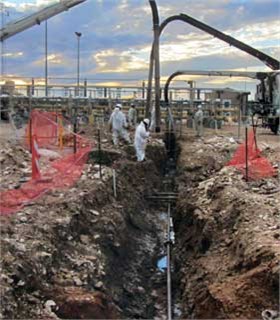Some Of Demolition
Wiki Article
Some Known Questions About Grading Contractors.
Table of ContentsExcavating Contractors Fundamentals ExplainedFacts About Excavating Contractors RevealedThings about Mini ExcavatorThe Greatest Guide To TrencherThe Best Strategy To Use For Trencher


Scrapers or Pans excavate soil in one location, haul and also dump the dirt in another place (excavation companies). It is difficult to match the effectiveness of scrapes for cut/fill soil operation if the haul range is less then a mile. Scrapers are generally pulled by a rubber tire wheel tractor as well as are in some cases pressed with the cut area by a bulldozer.
There are lot of times that scrapers are not utilized for website grading and also a dump vehicle is utilized: the haul may be to long, the haul might cross roadways where scrapers are not permitted, hard rock may be experienced, devices accessibility, and so on. Unload vehicles are in usual use and probably need little conversation.
"Rock body" beds, on the various other hand, have no tailgates as well as can discard any kind of dimension rock, although their volume ability is lessened. Compaction Equipment boosts the density of the dirt and also in some situations gives a smooth, rolled surface area.
Trencher - An Overview
From a basic examination pit to percussion boring to core drilling the owner has increasingly more costly alternatives that produce significantly better information regarding the site underground. For instance, the Owner on a 100,000 SF structure project might authorize twenty boring places with split spoon soil samples taken till rock is gotten to and afterwards core samples of rock.Recognizing the type as well as quality of rock (from the core examples) and area of rock (from the dirts boring) is an actual benefit in jobsite preparation. Conversely, the Proprietor of a 100,000 SF structure may decide to proceed with no geotechnical screening whatsoever. The decision regarding geotechnical screening is generally made by an Owner without any input from the Construction Manager.
A knowledge of the approximate location of the rock helps the Construction Manager to intend the series of actions adhering to rock excavation. If rock is in one corner of a big building project, for example, the earth excavation could start at the contrary end of the structure in order to start foundation job soonest.
Starting the structure work early would be an excellent suggestion if the rock might be gotten rid of by ripping. Nonetheless, if the rock is very difficult and requires considerable blasting, it might be prudent to hold foundation work until the blasting is finished. The Building Supervisor should collaborate these sorts of decisions and also utilize all the technological day readily available.
Getting The Excavation Companies To Work
Unclassified excavation stipulates that all rock or various other unanticipated materials (leaving out harmful products) come across in the sitework will be the duty of the Professional at no change in contract cost. An unclassified excavation is less complex from a book-keeping viewpoint and places the responsibility for geotechnical problems onto the Sitework Service provider.Exactly How Water Impacts Sitework? It's remarkable what a hefty rainfall can do to a building task. Prior to the rainfall, the website may be dry, hefty devices efficiently relocating planet, the other professions efficiently doing their work. Within hrs the task can be a sloppy, mud-hole with worker performance cut to about 10%.
In a lot of locations of the world, the Building and construction Manager should remember an easy truth: IT WILL RAINFALL. Excellent preparation can lessen the damages and disruption of a heavy rain to a jobsite. Often the excavation and also grading is left to the Sitework Contractor (as well as their Foremen is responsible to manage and direct the heavy equipment and also operators).
As A Result the Building and construction Supervisor must be continually familiar with what rainfall will certainly do to the project website. It is not unusual for the Sitework Supervisor to function their heavy devices for optimal effectiveness and hope it does not rainfall. Among the finest ways to get ready for rain is to slope all qualities to drain pipes and also to smooth rolled the surface before a rain.
More About Excavating Contractors
The Building and construction Supervisor have to be well-balanced enough to guarantee that heavy rain does not quit working on the task longer than needed. Daily discussions with Sitework Foremen might be required to accomplish this objective. At any time excavation is needed below the existing water table on a project, the procedure of dewatering have to be taken into consideration.In a genuinely natural dirt, the water takes a trip so gradually via the clay or silt that dewatering is not normally necessary for the relatively short time of excavation. Dewatering may be needed for a solitary footing excavation or for a whole task site. The most typical dewatering approaches are trench drains, deep wells as well as Going Here well factors.

Ground water seepage can additionally be reduced by cutoff techniques such as sheet stacking. High dewatering expenses have paled the revenue margins on much also numerous projects.
This alternative needs to always be considered when examining the prospect of backhoe service dewatering. Clearly the option is just sensible if gravity can run the water to reduced ground. Trench drains can be cut with a backhoe and also loaded with a coarse, granular product (# 4 stone as an example), but care must be exercised in picking the water electrical outlet kind and also location.
All about Grading Contractors
A siphon, by interpretation, uses air pressure to carry water from one altitude, up over a challenge, to a lower altitude. The pipes in a siphon system should be airtight as well as some ingenuity is commonly required to completely fill up the siphon pipe. The siphon pipeline need to be full for the siphon to begin.A deep well includes a pump, hose pipe as well as an upright well casing. The pump consumption is at the base of the well covering (typically some crushed rock is put down there as a filter tool) (demolition). The water is inflated the pipe, out of the well casing, and to an appropriate discharge location.
In a rugged sand, as an example, a large location can be pumped to near the pump intake elevation. A much less absorptive soil, on the other hand, minimizes the efficiency of a deep find well. Since the pump is generally at the base of the deep well, there are no height limitations as a result of vacuum lift, and also deep wells can lower the groundwater over 50 feet.
Under of the wellpoint there is a 2 foot long screen as well as valve, water jets out of this shutoff and creates a hole into which the wellpoint pipeline can be lowered. This opening is commonly made a bigger size (for instance 10 inches) to permit for a rugged sand backfill to help filter the water (excavator).
Report this wiki page